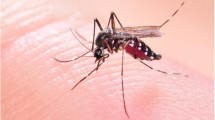Abstract
The WHO adult susceptibility test is in use for insecticide resistance monitoring. Presently, materials are being imported from the Universiti Sains Malaysia, Malaysia and sometimes it is cost prohibitive. As an alternative, we present here a method of bottle bioassay using indigenous material. Different aspects related to the assay were studied and validated in the field. Bottle assay was standardized in the laboratory by using locally sourced material and laboratory-maintained insecticide-susceptible Anopheles stephensi and Aedes aegypti strains against technical grade deltamethrin and cyfluthrin insecticides dissolved in ethanol in a range of different concentrations. The frequency of use of the deltamethrin-coated bottles and shelf-life were determined. Discriminating dose for deltamethrin and cyfluthrin was 10 μg against An. stephensi and 2 μg against Ae. aegypti females. Insecticide-coated bottles stored at 25 to 35 °C can be used for three exposures within 7 days of coating. The study carried out in the laboratory was validated on wild caught An. culicifacies in the states of Odisha and Chhattisgarh against deltamethrin-coated bottles in comparison to WHO adult susceptibility test. Results of the study indicated that deltamethrin-coated bottles were effective up to three exposures within 7 days of coating for field population and 100 % mortality was recorded within 35 min as observed in laboratory studies for field collected susceptible population. Also in the WHO adult susceptibility test, 100 % knock-down within 35 min and 100 % mortality after 24 h holding period were observed in susceptible population, while in it was 50 % knock-down in 1 h and 64 % mortality after 24 h holding period for resistant population (50 % mortality in bottle assay in 60 min). The bottle assay can be used as an alternative to the WHO adult susceptibility test both in the laboratory and field for monitoring insecticide resistance in mosquito vectors using locally sourced material.





Similar content being viewed by others
References
Abbott WS (1925) A method of computing the effectiveness of an insecticide. J Econ Entomol 18:265–267
Aizoun N, Osse R, Azondekon R, Alia R, Oussou O, Virgile G, Rock A, Gil G, Martin A (2013) Comparison of the standard WHO susceptibility test and the CDC bottle bioassay for the determination of insecticide susceptibility in malaria vectors and their correlation with biochemical and molecular bioaasays in Benin, West Africa. Parasit Vectors 6:147
Brogdon W, Chan A (2010) Guidelines for evaluating insecticide resistance in vectors using the CDC bottle bioassay. CDC technical report. Methods in Anopheles research, 2 edn. CDC Atlanta, USA. p 343
Brogdon WG, McAllister JC (1998) Simplification of adult mosquito bioassays through use of time-mortality determinations in glass bottles. J Am Mosq Control Assoc 14:159–164
Finney DJ (1971) Probit analysis. Cambridge University Press, Cambridge, p 33
Kothari CR (1988) Research methodology methods and techniques. Wiley Eastern Limited, New Delhi, p 500
Nusrat J, Noreen M (2010) Evaluation of resistance against deltamethrin in Aedes mosquitoes from Lahore, Pakistan. Biol Pak 56:9–15
Nusrat J, Shahid A (2013) Evaluation of resistance against deltamethrin and cypermethrin in dengue vector from Lahore, Pakistan. J Anim Plant Sci 23(5):1321–1326
Perea EZ, Leon RB, Salcedo MP, Brogdon WG, Devine GJ (2009) Adaptation and evaluation of the bottle assay for monitoring insecticide resistance in disease vector mosquitoes in the Peruvian Amazon. Malar J 8:208
Raghavendra K, Barik TK, Reddy BP, Sharma P, Dash AP (2011) Malaria vector control: from past to future. Parasitol Res 108(4):757–779
Saelim V, Brogdon WG, Rojanapremsuk J, Suvannadabba S, Pandii W, Jones JW, Sithiprasasna R (2005) Bottle and biochemical assays on temephos resistance in Aedes aegypti in Thailand. Southeast Asian J Trop Med Public Health 36:417–425
World Health Organization (1998) Test procedures for insecticide resistance monitoring in malaria vectors, bio-efficacy and persistence of insecticides on treated surfaces (WHO/CDS/CPC/MAL/98.12). WHO, Geneva
Yersin C, Bovet P, Herminie P, Zeller H (1999) Public health importance of mosquito borne disease in the Seychelles (Indian Ocean). Infect Dis Rev 1(3):189–199
Acknowledgments
The authors thank director, NIMR, New Delhi for giving continuous encouragement for doing this work and ICMR for the financial support for this work. The authors express sincere thanks to M/S Bayer CropScience Ltd for providing gratis the technical grade deltamethrin and cyfluthrin. The authors acknowledge M/S Narender Sharma, Kamal Dev, UV Singh, KK Gupta, MA Haque, SK Satpati, Ruchika Kataria, and Anuraj Tirkey for the technical support.
Competing interests
The authors declare that they have no competing interests.
Author information
Authors and Affiliations
Corresponding author
Rights and permissions
About this article
Cite this article
Elamathi, N., Barik, T.K., Verma, V. et al. Standardization of a bottle assay—an indigenous method for laboratory and field monitoring of insecticide resistance and comparison with WHO adult susceptibility test. Parasitol Res 113, 3859–3866 (2014). https://doi.org/10.1007/s00436-014-4054-y
Received:
Accepted:
Published:
Issue Date:
DOI: https://doi.org/10.1007/s00436-014-4054-y




